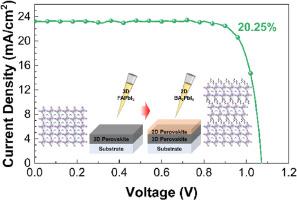具有双层结构的钙钛矿太阳能电池的船舵-popper相,以提高稳定性和性能
IF 6.3
2区 材料科学
Q2 ENERGY & FUELS
引用次数: 0
摘要
有机-无机钙钛矿太阳能电池已经显示出相当大的发展,这些令人印象深刻的性能增强引起了对其商业应用的极大兴趣。钙钛矿商业化的主要研究挑战是其长期稳定性。在这项研究中,我们的目标是通过使用3D FAPbI3 (FA = formamidinium)和2D BA2PbI4 (BA = butylammonium)钙钛矿的双层结构来提高钙钛矿太阳能电池的稳定性和性能。通过双自旋涂层在三维层表面连续形成二维钙钛矿层,并使用不同浓度的BA2PbI4溶液控制二维层的厚度。引入二维钙钛矿通过防止水分进入有效抑制了湿度引起的降解,并通过钝化表面陷阱状态减少了复合损失,从而大大提高了钙钛矿太阳能电池的稳定性和性能。结果表明,具有55 nm厚2D层的双层钙钛矿太阳能电池在85°C, 85%相对湿度下,在500 h的长期稳定性下保持了初始效率的约93%,并表现出20.25%的最佳效率。本文章由计算机程序翻译,如有差异,请以英文原文为准。

Bilayer structure perovskite solar cells with ruddlesden-popper phase for improved stability and performance
Organic-inorganic perovskite solar cells have shown considerable development, and these impressive performance enhancements have generated much interest in their commercial use. The main research challenge in the commercialization of perovskite is its long-term stability. In this study, we aim to improve the stability and performance of the perovskite solar cells by using a bilayer structure of 3D FAPbI3 (FA = formamidinium) and 2D BA2PbI4 (BA = butylammonium) perovskites. The 2D perovskite layer was continuously formed along the surface of the 3D layer via double spin coating, with the 2D layer thicknesses being controlled using various BA2PbI4 solution concentrations. Introducing the 2D perovskite effectively suppresses humidity-induced degradation by preventing moisture ingress and reduces recombination loss by passivating surface trap states, thereby considerably improving both the stability and performance of perovskite solar cells. As a result, a bilayer perovskite solar cell with a 55 nm-thick 2D layer maintained ∼93 % of its initial efficiency after 500 h in long-term stability under 85 % relative humidity at 85 °C and exhibited the best efficiency of 20.25 %.
求助全文
通过发布文献求助,成功后即可免费获取论文全文。
去求助
来源期刊

Solar Energy Materials and Solar Cells
工程技术-材料科学:综合
CiteScore
12.60
自引率
11.60%
发文量
513
审稿时长
47 days
期刊介绍:
Solar Energy Materials & Solar Cells is intended as a vehicle for the dissemination of research results on materials science and technology related to photovoltaic, photothermal and photoelectrochemical solar energy conversion. Materials science is taken in the broadest possible sense and encompasses physics, chemistry, optics, materials fabrication and analysis for all types of materials.
 求助内容:
求助内容: 应助结果提醒方式:
应助结果提醒方式:


